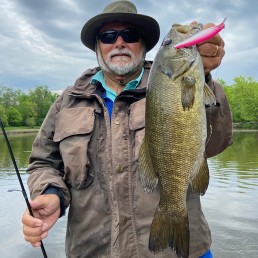Slow Down, Stay Down for Bass Just After Ice-Out
SHARE THIS POST
Even before lakes have fully shed their ice cover, some smallmouth bass begin probing the outer edges of shallow, sand-and-rock shorelines that rise into 8 feet of water or less. However, to catch them, you usually need to keep things relatively low and slow until the water temperature ticks up a bit.
Try tossing a hair jig or Ned Rig out and scraping it back across the bottom, using a crawling-pausing retrieve. It’ll pass directly in front of bass lying low to the bottom and likely provoke a few fish to gently pick up your lure as it passes before or near them.
On calm, sunny days, fish will also strike shallow-lipped, suspending lures presented at or near their depth level. But first thing in the morning, before the water—and thus the fish–warm up a bit, don’t expect them to rise to the 2- or 3-foot level, nearer the surface, to strike your lure, even if you impart long pauses to your retrieve. However, if you switch to a deeper-running suspender that gets down 4 to 7 feet, and hovers right before or slightly above their noses, you may trigger strikes. Thus, an X-Rap Deep or Shad Rap RS may be a better choice for the first few hours of the day.
As the water warms a bit due to sun exposure, bass responding by rising a few feet shallower to take advantage of warming surface that helps to warm their bodies. At this point, you may stop getting bumps and bites on your deeper lures because you are now fishing beneath the fish. Once you sense this change may be occurring, switch to short-lipped, shallower divers that suspend only a couple of feet deep when you pause your retrieve. Now, your bait hovers at or just above their level, and is more likely to garner strikes. You’ll probably also notice an increase in their aggressiveness, shifting from bumps and nudges to more willingly striking your lures.
It may only take a few days of warming water for smallies to begin penetrating the shallows to feed. As they do, shallow X-Rap 10s and other neutrally buoyant minnowbaits will do a real number on them. Toss one out and work it back with gentle sweeps of the rod tip, interspersed with long pauses to make the lure hover, which infuriates fish and turns watchers into biters. This dynamic presentation produces all the way up until bass begin building nests and stop chasing horizontal presentations, responding better at that point to vertical tactics like jigs or worms.
Are you enjoying this post?
You can be among the first to get the latest info on where to go, what to use and how to use it!
One more thing you may or may not have thought of for ultra-early fishing, just after ice-out: You will likely do better using monofilament line than non-stretch superline, because the inherent stretch of mono automatically softens your pulls and imparts less movement to your lures than superline, which makes lures dash and dart more because it doesn’t stretch. Superline is great later, once the water warms and fish respond to lures that move more aggressively. But right after ice-out, you need to keep things low and slow to get bass to respond. Early on, I vote for mono.
Just after ice-out, it’s all about observations and nuances. If you pay attention and adjust your tactics to fish depth, location and attitude, perhaps even changing lure styles as the day goes on to match changing fish behavior, you will likely catch more bass. After all, you carry all those different lures in your tackle box, so you might as well use them where and when they will catch you the most fish.
You’ll find plenty of helpful spring fishing tips in the April and May issues of MidWest Outdoors. Subscribe on our website.
MWO
SHARE THIS POST
You may also like...
Nothing found.
Did you enjoy this post?
You can be among the first to get the latest info on where to go, what to use and how to use it!
Dave Csanda
Dave Csanda has enjoyed 40 years in the fishing communications industry at In-Fisherman, Angling Edge and now, as editor of MidWest Outdoors. He is an inductee of both the Minnesota and National Fresh Water Fishing Halls of Fame.
